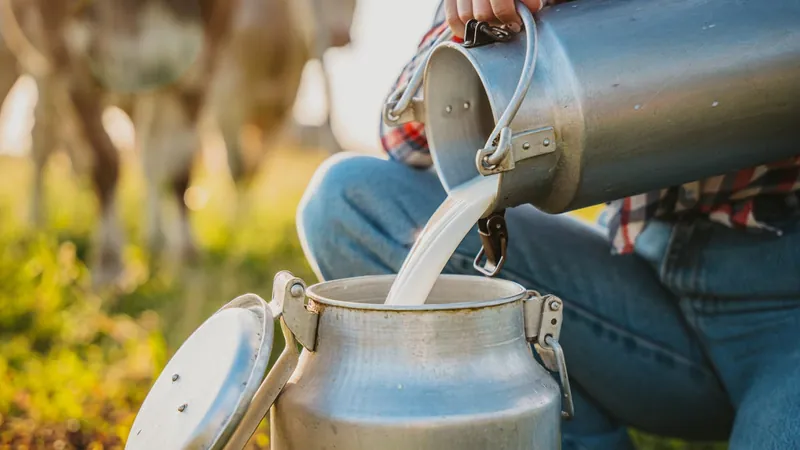
The USDA Tests Raw Milk for Avian Flu: Is Raw Milk Really Safe to Drink?
2024-11-13
Author: Jessica Wong
Introduction
In a noteworthy move, the U.S. Department of Agriculture (USDA) has announced it will start testing bulk batches of raw milk nationwide for traces of the avian flu virus, a situation that has escalated following a significant outbreak affecting cattle in California earlier this year.
Testing Findings
During a press conference on May 1, representatives from the CDC, FDA, and USDA revealed alarming findings: testing of commercial dairy products showed that one in five samples contained remnants of the H5N1 bird flu virus. Fortunately, none of these samples harbored live viruses capable of causing illness in humans. Health authorities reiterated that pasteurization effectively eliminates the bird flu virus, reinforcing the general safety of pasteurized milk.
Rising Trend of Raw Milk Consumption
Despite these reassurances, the trend of consuming raw dairy products has been growing, prompting the CDC to issue stronger warnings in May. The agency confirmed that high levels of the A(H5N1) virus can be found in unpasteurized and thus potentially unsafe 'raw' milk, leading them to advise consumers to steer clear of such products entirely.
Understanding Raw Milk
Raw milk is defined as milk that has not undergone pasteurization—a process that uses heat to eliminate harmful microorganisms. Meghan Davis, an expert from Johns Hopkins Bloomberg School of Public Health, emphasizes that skipping this crucial step poses significant health risks.
Health Organization Warnings
Prominent health organizations, including the FDA and CDC, have consistently flagged concerns regarding raw milk consumption. These agencies point to severe health threats that can impact not just the individual consuming raw milk, but also those in close proximity. Individuals with weakened immune systems—like toddlers, pregnant women, and the elderly—are particularly vulnerable to its dangers.
Nutritional Myths
Registered dietitian Jamie Nadeau stresses a common misconception among raw milk advocates—that pasteurization reduces the nutritional value of the milk. This belief is unfounded, as research shows that the nutritional differences are negligible. 'When considering the pros and cons, opting for pasteurized milk is a no-brainer,' Nadeau says.
Risks of Raw Milk Consumption
The major downside of consuming raw milk is the risk of encountering harmful pathogens, which can lead to severe illnesses such as Guillain-Barré syndrome and hemolytic uremic syndrome. Even consistent consumers of raw milk can fall ill unexpectedly, despite reassurances of farm hygiene or animal health. 'There’s no way to guarantee raw milk is safe, regardless of its source,' Nadeau explains.
Misconceptions and Alternatives
Misconceptions about the health benefits of raw milk persist, with some suggesting it's healthier because it is 'less processed.' However, Nadeau argues that the nutritional changes post-pasteurization are minimal, and pasteurized milk is just as healthy, if not safer.
For individuals seeking less-processed options, Davis recommends purchasing commercially pasteurized but non-homogenized milk—often labeled as 'cream top'—which retains a fresher taste while ensuring it has undergone the necessary safety measures.
Furthermore, the notion that bacteria in raw milk benefits gut health is largely exaggerated. Nadeau recommends alternatives like yogurt, kefir, or probiotic supplements for those looking to enhance gut health.
Conclusion
In summary, as the USDA intensifies its testing of raw milk amid the avian flu concerns, experts uniformly advise against its consumption. The potential health risks far outweigh any perceived benefits, making pasteurized milk the safer choice for consumers. In light of current outbreaks and ongoing health warnings, ensuring milk safety is undeniably pivotal for both personal and public health.


 Brasil (PT)
Brasil (PT)
 Canada (EN)
Canada (EN)
 Chile (ES)
Chile (ES)
 España (ES)
España (ES)
 France (FR)
France (FR)
 Hong Kong (EN)
Hong Kong (EN)
 Italia (IT)
Italia (IT)
 日本 (JA)
日本 (JA)
 Magyarország (HU)
Magyarország (HU)
 Norge (NO)
Norge (NO)
 Polska (PL)
Polska (PL)
 Schweiz (DE)
Schweiz (DE)
 Singapore (EN)
Singapore (EN)
 Sverige (SV)
Sverige (SV)
 Suomi (FI)
Suomi (FI)
 Türkiye (TR)
Türkiye (TR)